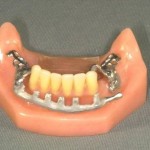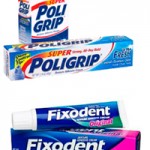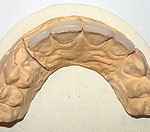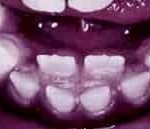The swing-lock removable partial denture (SL), was introduced by Simmons in the early 1960s. Swing lock partial dentures are designed for dental patients who have depleted dentition. They are sometimes used because traditional partial dentures can be unreliable due to rather limited bracing and clasping abilities. These limitations result in a weak resistance to rotational forces. To overcome this problem, the swing lock partial denture design makes it possible to clasp multiple teeth at a time, therefore increasing the bracing and reduce the rotational movements of the denture. Continue reading
Author Archives: chzechze
What Are the Dangers of Denture Creams?
If you’re one of the 35 million Americans who wear dentures, take note — your denture cream could be putting your health at risk. Researchers have recently discovered a link between the zinc in denture adhesives and nerve damage. Several popular denture creams, including Super Poligrip and Fixodent, contain zinc. If you’ve used those products and now have tingling or numbness in your hands or feet, poor balance or unexplained weakness, contact your doctor immediately. Continue reading
Types of Ultrathin Dentures
Dentures have a bad rap of being unsightly, uncomfortable, and difficult to eat with. However, advances in the way that dentures are made have resulted in dentures that are easy to wear, look great, and—most importantly—fit snugly and comfortably. Ultrathin dentures may be made out of a variety of materials and can fit any number of budgets. Continue reading
Types of Dental Night Guards
Dental night guards are one of several treatment methods prescribed by a dentist to address various types of dental disorders. These problems occur during sleep and can cause damage to teeth and overall mouth alignment. Dental night guards are either custom-made or purchased over the counter. The decision regarding which type of dental night guard to use is based on the problem to be corrected. Continue reading
Types of Dental Implants
There are many implants available, each designed for a specific function. Dental implant types can be categorized in different ways:
- By the type of connection on top of the head of the implant- internal/external hexagon, octagon, etc.
- By size- Wide, standard or narrow dental implants, Continue reading
The Side Effects of Veneers
Dental veneers are a thin coating of ceramic that is placed over the tooth on the outer side of the tooth. The placement of veneers on your teeth will give you a brighter smile and improve the appearance of your teeth. The cosmetic treatment consists of thin, customized, tooth-colored shells that qualified dentists bond to the outer surface of teeth. Dental veneers can correct problems related to the color, length, size and shape of teeth when properly constructed and attached. Continue reading
The Safety of an MRI for Dental Implants
Dental implants can pose difficulties for an individual having an MRI (magnetic resonance imaging), but do not automatically rule out undergoing the procedure, according to Frank G. Shellock, PhD. Shellock has studied the safety and biological effects of magnetic resonance imaging for 25 years and has identified several areas of concern for those with dental implants. Continue reading
Tips for Extraction of Baby Teeth
All people at some point in their lives will need to have their baby teeth extracted. The primary reason for extracting these teeth is to make room for permanent teeth. Other reasons for extraction are to prevent the crowding of teeth in the mouth, circumvent tooth decay or prevent injury to the inside of the jaw. No matter which of these scenarios describes your circumstances, there are a number of ways to safely extract baby teeth. Continue reading
The Ingredients in Freedent Gum
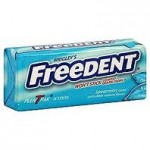 Freedent, the first non-stick chewing gum, was introduced by the Wrigley Company in 1975. Freedent was developed for those who can’t chew regular gum due to dentures and dental work. As of 2010, Freedent is available in Canada, the U.S., France and New Zealand. Wrigley’s Freedent gum comes in peppermint and spearmint. The ingredients of both flavors are nearly identical; the only difference is the peppermint or spearmint oil used for flavoring. Continue reading
Freedent, the first non-stick chewing gum, was introduced by the Wrigley Company in 1975. Freedent was developed for those who can’t chew regular gum due to dentures and dental work. As of 2010, Freedent is available in Canada, the U.S., France and New Zealand. Wrigley’s Freedent gum comes in peppermint and spearmint. The ingredients of both flavors are nearly identical; the only difference is the peppermint or spearmint oil used for flavoring. Continue reading
The Ozone Treatment for Cavities
Can ozone be used to treat caries (cavities) without the need for drilling and filling? It seems that ozone therapy in dentistry is coming of age. If one of your teeth has only small areas of decay, we can often use ozone treatment to sterilise it. Bacteria that causes tooth decay is found deep within the tooth structure. Removing these bacteria would usually mean amputating the infected area of the tooth (and there’s always the risk that infected areas could be left behind). A further concern would be that the fillings put into the tooth are not a permanent solution, on average they last between 6 months and a couple of years. Each time the filling is replaced, the filling has to be larger and more of the tooth is damaged. This downward spiral usually leads to expensive dental reconstruction. Continue reading
